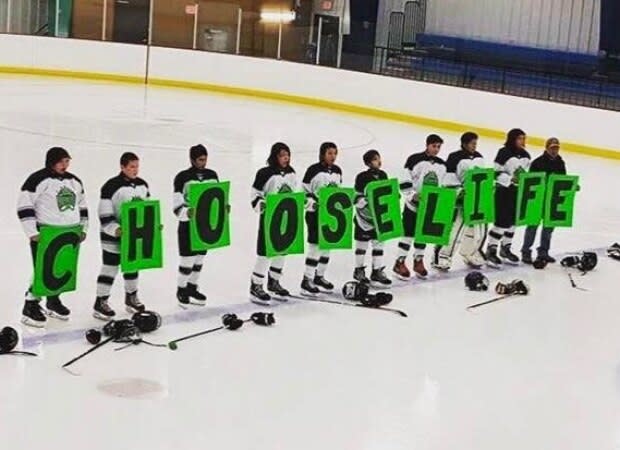How Ottawa and a First Nations organization found common ground on fighting youth suicide
An agreement struck in 2017 between Indigenous Services Canada and the Nishnawbe Aski Nation on faster funding for suicide prevention projects is "making a huge impact," says NAN Grand Chief Alvin Fiddler.
What's known as the Choose Life initiative created a streamlined and quick turn-around process for First Nations that are part of the Nishnawbe Aski Nation organization that need funding to deal with youth who are facing a serious risk of suicide.
"It's saving lives. I don't know how else to say it," said Fiddler.
"It's empowering our communities to look after our children rather than losing them to the child welfare system."
The agreement came about through the ongoing on-reserve child welfare discrimination case before the Canadian Human Rights Tribunal.
NAN, which represents 49 First Nations in northern Ontario, joined the human rights case in May 2016 following the January ruling that year from the tribunal that found Ottawa discriminated against First Nations children by under-funding on-reserve child welfare services.
The initiative was created through an agreement struck in 2017 between Indigenous Services Canada (ISC) and NAN which was seeking a "Choose Life" order from the human rights tribunal. The tribunal endorsed the agreement.
NAN wanted the tribunal to order ISC to provide Jordan's Principle funding to proposals from First Nations who have children and youth at high risk of suicide. Under Jordan's Principle, a child's need for services is placed ahead of jurisdictional questions between governments and departments over who should pay for them.
NAN sought the motion to prevent a repeat of what happened in the NAN community of Wapekeka, where two 12-year-old girls died by suicide in January 2017.
Months before the suicides, Wapekeka leadership requested funding from Health Canada to deal with some community youth who had formed a suicide pact. The request sat idle for months because it came "at an awkward time in the federal funding cycle," a department official told CBC News at the time.
Then in February 2017, an 11-year-old and a 21-year-old died by suicide in two other NAN communities.
Shortly after the tragedies, a hockey team from Kitchenuhmaykoosib Inninuwug, where the 11-year-old girl was from, held up letters to spell "Choose Life" before a game during a tournament in Sioux Lookout.
"It inspired me and a lot of people to get up and do something," said Fiddler.
"That is how this whole Choose Life initiative came to life."
Tribunal was 'pleased' by agreement
The federal government is currently before the Federal Court seeking a judicial review aimed at quashing an order from the tribunal issued in September for Ottawa to provide $40,000 each to First Nations children taken from their communities and extended families through the on-reserve child welfare system and in Yukon.
While most of the focus of the ongoing case has been over the litigation over compensation, the Choose Life initiative grew from co-operation between the federal government and NAN before the tribunal.
"The [tribunal] is very pleased to learn about this significant agreement that will have positive and real impact on the lives of Indigenous children," said the tribunal, in a Feb.1, 2018, ruling.
"It is also a sign that meaningful agreements can be made in a relatively short time frame in the best interest of children."
In March 2017, Health Canada's First Nations and Inuit Health Branch struck a Choose Life working group with NAN to create a new, streamlined process for First Nations dealing with youth at serious risk of suicide.
Response within 12 hours
Now, both NAN and ISC have designated officials to deal with these kinds of requests. The department responds within 12 hours once an application is filed, said Valerie Gideon, senior assistant deputy minister for the First Nations and Inuit Health Branch.
Gideon said a "Choose Life" steering committee she co-chairs with a NAN representative reviews any aspects of proposals that initially fail to qualify for funding.
"A denial cannot be made exclusively by the federal government," said Gideon.

Since June 2017, the initiative has seen 208 applications approved for a total of about $173 million which has benefited thousands of children, said Gideon. The money has flowed through the Jordan's Principle umbrella, she said.
"It is a best practice. We think the evaluation will demonstrate that. That is what we are hearing," she said.
Before the initiative communities faced a "mishmash of stuff" to cobble together in order to find funding to deal with the cycles of suicide that grip northern Ontario First Nations, said Fiddler.
"Communities were just left on their own," said Fiddler.
Counselling and on-the-land activities
Some of the projects approved include on-the-land activities and traditional gatherings, as well as things like case management and counselling, special needs assessments and family support services.
For example, under the initiative, Kitchenuhmaykoosib Inninuwug held a 15-day canoe trip, and in Weenusk First Nation, elders and youth were brought together for Cree classes, hunting, fishing, snaring and a meals-on-wheels program.
Mattagami First Nation set up on-the-land youth camps to teach harvesting and trapping skills, while Ginoogamang First Nation brought in traditional healers and held medicine walks. In Kasabonika First Nation there are now summer and fall camps for youth on the land.
"It allows our communities more room to be creative and innovative in how they want to work with children on the ground or out on the land and in the community," said Fiddler.
Fiddler said the initiative was given a three-year extension in March and that he has told Indigenous Services Minister Marc Miller it should be permanent.

